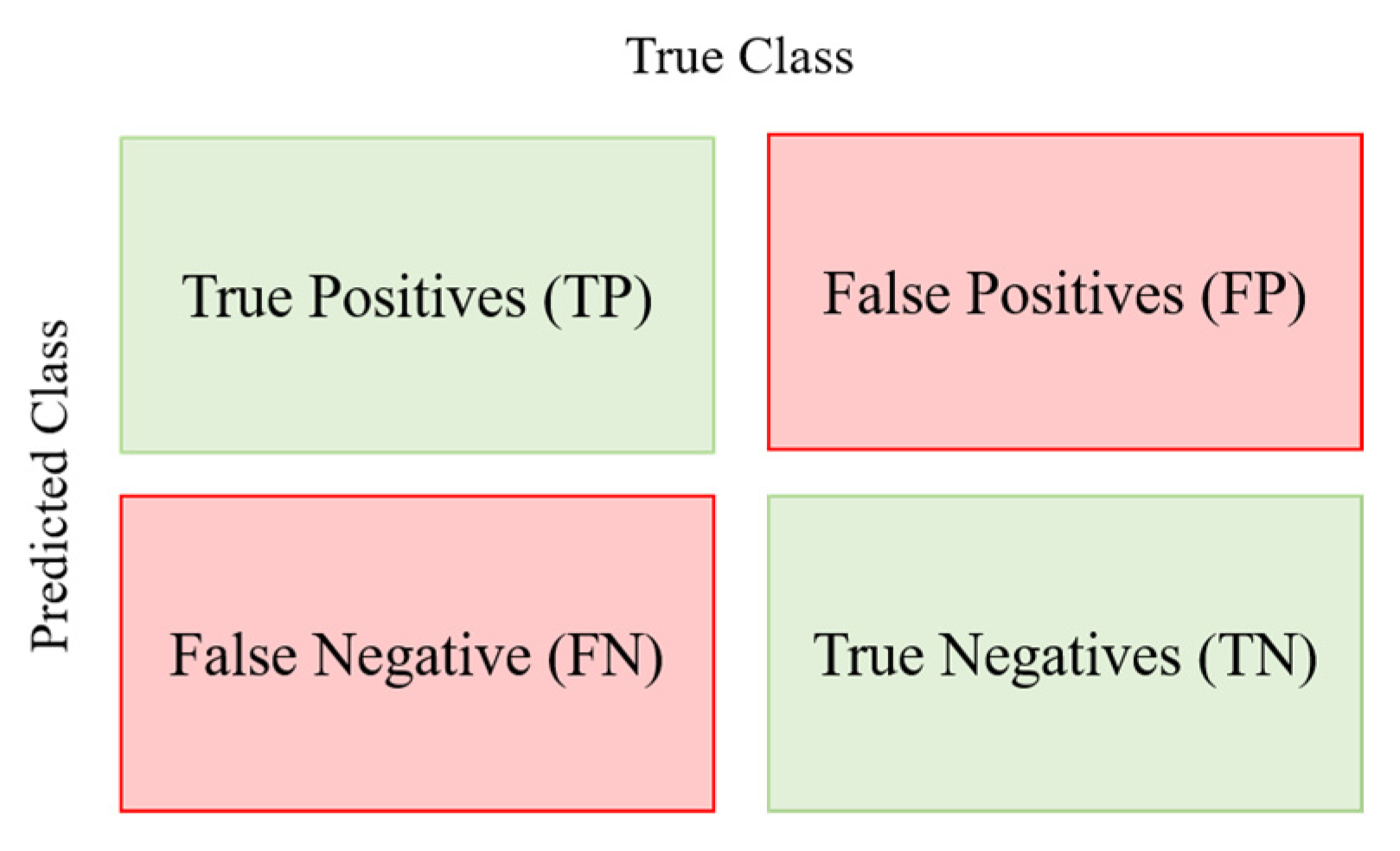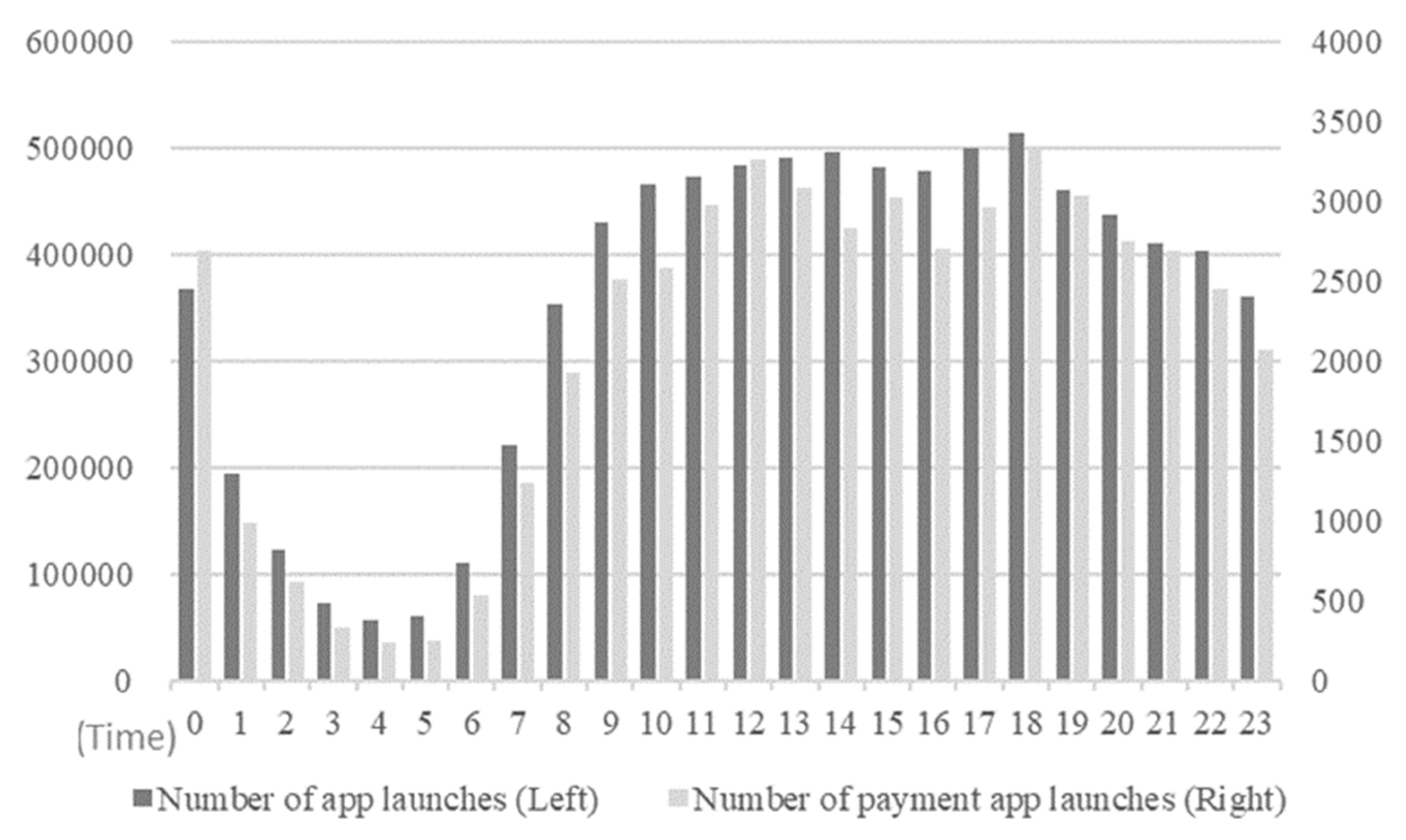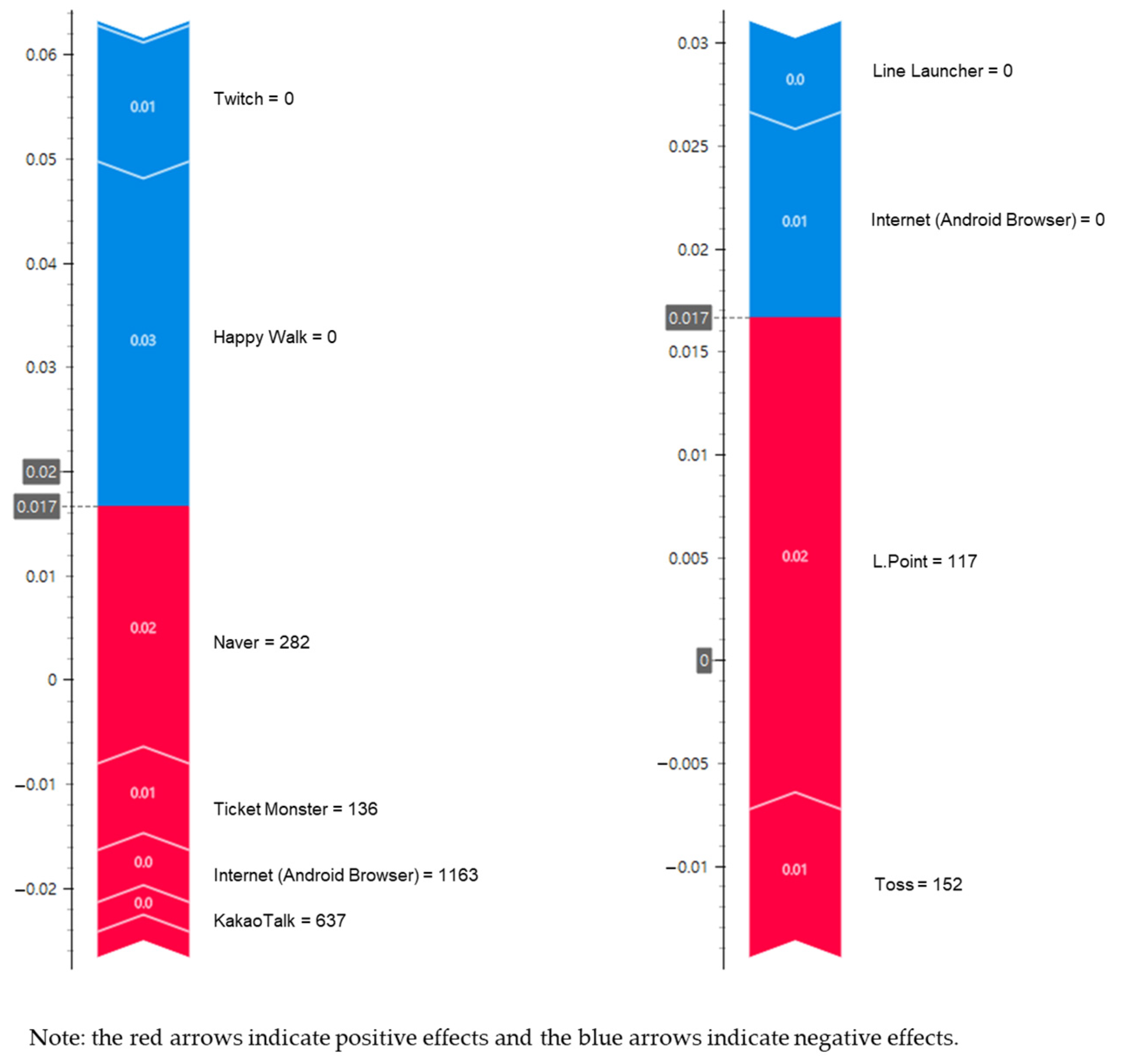Predicting Mobile Payment Behavior Through Explainable Machine Learning and Application Usage Analysis
Abstract
1. Introduction
- (1)
- Can diverse mobile application usage behavior variables improve the accuracy of predicting mobile payment behavior?
- (2)
- Which mobile applications most significantly influence consumers’ mobile payment behavior?
- (3)
- How do hedonic motivations (e.g., YouTube use) and social connectivity (e.g., social networking service use) relate to mobile payment usage?
2. Literature Review and Hypotheses Development
2.1. Determinants of Mobile Payment Behavior
2.2. Impact of SNSs on Users’ Mobile Payment Behavior
2.3. Impact of YouTube Viewing on Mobile Users’ Payment Behavior
3. Method
3.1. Data and Samples
3.2. Predictive Algorithms and Explainable ML Techniques
3.2.1. XGBoost
3.2.2. LightGBM
3.2.3. CatBoost
3.2.4. SHAP
3.2.5. Performance Metrics of the Classification Problem
4. Results
5. Discussion
5.1. Theoretical Implications
5.2. Managerial Implications
5.3. Limitations and Future Research
6. Conclusions
Author Contributions
Funding
Institutional Review Board Statement
Informed Consent Statement
Data Availability Statement
Conflicts of Interest
Appendix A
Appendix A.1. Details of eXtreme Gradient Boosting (XGBoost)
Appendix A.2. Details of Light Gradient-Boosting Machine
Appendix A.3. Details of Category Boosting (CatBoost)
References
- Oliveira, T.; Thomas, M.; Baptista, G.; Campos, F. Mobile payment: Understanding the determinants of customer adoption and intention to recommend the technology. Comput. Hum. Behav. 2016, 61, 404–414. [Google Scholar] [CrossRef]
- Gupta, A.; Arora, N. Understanding determinants and barriers of mobile shopping adoption using behavioral reasoning theory. J. Retail. Consum. Serv. 2017, 36, 1–7. [Google Scholar] [CrossRef]
- Cheng, H.H.; Fu, T.J. The Determinants of online shopping behavior. In Proceedings of the 2018 IEEE International Conference on Intelligent Autonomous Systems (ICoIAS), Singapore, 1–3 March 2018; pp. 97–100. [Google Scholar] [CrossRef]
- Yu, T.; Wu, G. Determinants of Internet Shopping Behavior: An Application of Reasoned Behaviour Theory. Int. J. Manag. 2007, 24, 744. Available online: https://www.researchgate.net/publication/285469933_Determinants_of_internet_shopping_behavior_An_application_of_reasoned_behaviour_theory (accessed on 27 May 2025).
- Hongxia, P.; Xianhao, X.U.; Weidan, L.I.U. Drivers and barriers in the acceptance of mobile payment in China. In Proceedings of the 2011 IEEE International Conference on E-Business and E-Government (ICEE), Shanghai, China, 6–8 May 2011; pp. 1–4. [Google Scholar] [CrossRef]
- Liébana-Cabanillas, F.; Marinkovic, V.; De Luna, I.R.; Kalinic, Z. Predicting the determinants of mobile payment acceptance: A hybrid SEM-neural network approach. Technol. Forecast. Soc. Change 2018, 129, 117–130. [Google Scholar] [CrossRef]
- Mahran, A.F.; Enaba, H.M.L. Exploring determinants influencing the intention to use mobile payment service. Int. J. Cust. Relatsh. Mark. Manag. 2011, 2, 17–37. [Google Scholar] [CrossRef]
- Wong, C.H.; Lee, H.S.; Chua, B.H.; Chai, B.H.; Tan Han, G.W. Predicting the Consumers’ Intention to Adopt Mobile Shopping: An Emerging Market Perspective. Int. J. Netw. Mob. Technol. 2012, 3, 24–39. Available online: https://www.researchgate.net/publication/279298682_Predicting_the_Consumers’_Intention_to_Adopt_Mobile_Shopping_An_Emerging_Market_Perspective (accessed on 27 May 2025).
- Exploding Topics. Time Spent Using Smartphones. 2023. Available online: https://explodingtopics.com/blog/smartphone-usage-stats#top-smartphone-stats (accessed on 27 May 2025).
- Hong, I.B.; Cha, H.S. The mediating role of consumer trust in an online merchant in predicting purchase intention. Int. J. Inf. Manag. 2013, 33, 927–939. [Google Scholar] [CrossRef]
- Lee, Y.K.; Park, J.H.; Chung, N.; Blakeney, A. A unified perspective on the factors influencing usage intention toward mobile financial services. J. Bus. Res. 2012, 65, 1590–1599. [Google Scholar] [CrossRef]
- Shin, C.; Hong, J.H.; Dey, A.K. Understanding and prediction of mobile application usage for smart phones. In Proceedings of the 2012 ACM Conference on Ubiquitous Computing, Pittsburgh, PA, USA, 5–8 September 2012; pp. 173–182. [Google Scholar] [CrossRef]
- Wang, R.J.H.; Malthouse, E.C.; Krishnamurthi, L. On the go: How mobile shopping affects customer purchase behavior. J. Retail. 2015, 91, 217–234. [Google Scholar] [CrossRef]
- Bigne, E.; Ruiz, C.; Sanz, S. The Impact of Internet User Shopping Patterns and Demographics on Consumer Mobile Buying Behaviour. J. Electron. Commer. Res. 2005, 6, 193. Available online: https://www.researchgate.net/publication/228635427_The_impact_of_internet_user_shopping_patterns_and_demographics_on_consumer_mobile_buying_behaviour (accessed on 27 May 2025).
- Korhonen, H.; Arrasvuori, J.; Väänänen-Vainio-Mattila, K. Analysing user experience of personal mobile products through contextual factors. In Proceedings of the 9th International Conference on Mobile and Ubiquitous Multimedia, Limassol, Cyprus, 1–3 December 2010; pp. 1–10. [Google Scholar] [CrossRef]
- Li, M.; Dong, Z.Y.; Chen, X. Factors influencing consumption experience of mobile commerce: A study from experiential view. Internet Res. 2012, 22, 120–141. [Google Scholar] [CrossRef]
- Pal, A.; Herath, T.; De’, R.; Rao, H.R. Contextual facilitators and barriers influencing the continued use of mobile payment services in a developing country: Insights from adopters in India. Inf. Technol. Dev. 2020, 26, 394–420. [Google Scholar] [CrossRef]
- De La Rosa, W.; Tully, S.M. The impact of payment frequency on consumer spending and subjective wealth perceptions. J. Consum. Res. 2022, 48, 991–1009. [Google Scholar] [CrossRef]
- Murray, K.B.; Di Muro, F.; Finn, A.; Leszczyc, P.P. The effect of weather on consumer spending. J. Retail. Consum. Serv. 2010, 17, 512–520. [Google Scholar] [CrossRef]
- Sandqvist, A.P.; Siliverstovs, B. Is it good to be bad or bad to be good? Assessing the aggregate impact of abnormal weather on consumer spending. Empir. Econ. 2021, 61, 3059–3085. [Google Scholar] [CrossRef]
- Dinner, I.M.; Van Heerde, H.J.; Neslin, S. Creating Customer Engagement via Mobile Apps: How App Usage Drives Purchase Behavior; Tuck School of Business Working Paper 2669817; Tuck School of Business: Hanover, NH, USA, 2015. [Google Scholar] [CrossRef]
- Huang, H.; Zhao, B.; Zhao, H.; Zhuang, Z.; Wang, Z.; Yao, X.; Wang, X.; Jin, H.; Fu, X. A cross-platform consumer behavior analysis of large-scale mobile shopping data. In Proceedings of the 2018 World Wide Web Conference, Lyon, France, 23–27 April 2018; pp. 1785–1794. [Google Scholar] [CrossRef]
- Zeng, M.; Cao, H.; Chen, M.; Li, Y. User behaviour modeling, recommendations, and purchase prediction during shopping festivals. Electron. Mark. 2019, 29, 263–274. [Google Scholar] [CrossRef]
- Liao, Z.X.; Pan, Y.C.; Peng, W.C.; Lei, P.R. On mining mobile apps usage behavior for predicting apps usage in smartphones. In Proceedings of the 22nd ACM International Conference on Information & Knowledge Management, San Francisco, CA, USA, 27 October–1 November 2013; pp. 609–618. [Google Scholar] [CrossRef]
- Crocker, J.; Canevello, A. Creating and undermining social support in communal relationships: The role of compassionate and self-image goals. J. Personal. Soc. Psychol. 2008, 95, 555. [Google Scholar] [CrossRef]
- Obst, P.; Stafurik, J. Online we are all able bodied: Online psychological sense of community and social support found through membership of disability-specific websites promotes well-being for people living with a physical disability. J. Community Appl. Soc. Psychol. 2010, 20, 525–531. [Google Scholar] [CrossRef]
- Bai, Y.; Yao, Z.; Dou, Y.F. Effect of social commerce factors on user purchase behavior: An empirical investigation from renren.com. Int. J. Inf. Manag. 2015, 35, 538–550. [Google Scholar] [CrossRef]
- Liang, T.P.; Turban, E. Introduction to the special issue social commerce: A research framework for social commerce. Int. J. Electron. Commer. 2011, 16, 5–14. [Google Scholar] [CrossRef]
- Klimmt, C.; Vorderer, P. Media psychology “is not yet there”: Introducing theories on media entertainment to the presence debate. Presence 2003, 12, 346–359. [Google Scholar] [CrossRef]
- Toubia, O.; Iyengar, G.; Bunnell, R.; Lemaire, A. Extracting features of entertainment products: A guided latent dirichlet allocation approach informed by the psychology of media consumption. J. Mark. Res. 2019, 56, 18–36. [Google Scholar] [CrossRef]
- Adorno, T.W.; Horkheimer, M. The culture industry: Enlightenment as mass deception. In Philosophers on Film from Bergson to Badiou: A Critical Reader; Columbia University Press: New York, NY, USA, 2019; pp. 80–96. [Google Scholar] [CrossRef]
- Schwemmer, C.; Ziewiecki, S. Social media sellout: The increasing role of product promotion on YouTube. Soc. Media Soc. 2018, 4, 2056305118786720. [Google Scholar] [CrossRef]
- Burgess, J.; Green, J. YouTube: Online Video and Participatory Culture; John Wiley & Sons: Hoboken, NJ, USA, 2018. [Google Scholar] [CrossRef]
- Zhou, R.; Khemmarat, S.; Gao, L.; Wan, J.; Zhang, J. How YouTube videos are discovered and its impact on video views. Multimed. Tools Appl. 2016, 75, 6035–6058. [Google Scholar] [CrossRef]
- Alhabash, S.; Mundel, J.; Hussain, S.A. Social media advertising: Unraveling the mystery box. In Digital Advertising; Routledge: Abingdon-on-Thames, UK, 2017; pp. 285–299. [Google Scholar] [CrossRef]
- Hoffman, E.W.; Pinkleton, B.E.; Weintraub Austin, E.; Reyes-Velázquez, W. Exploring college students’ use of general and alcohol-related social media and their associations with alcohol-related behaviors. J. Am. Coll. Health 2014, 62, 328–335. [Google Scholar] [CrossRef]
- Dhar, R.; Simonson, I. Making complementary choices in consumption episodes: Highlighting versus balancing. J. Mark. Res. 1999, 36, 29–44. [Google Scholar] [CrossRef]
- Lu, E.H.C.; Lin, Y.W.; Ciou, J.B. Mining mobile application sequential patterns for usage prediction. In Proceedings of the 2014 IEEE International Conference on Granular Computing (GrC), Noboribetsu, Japan, 22–24 October 2014; pp. 185–190. [Google Scholar] [CrossRef]
- Hirschman, E.C.; Holbrook, M.B. Hedonic consumption: Emerging concepts, methods and propositions. J. Mark. 1982, 46, 92–101. [Google Scholar] [CrossRef]
- Okada, E.M. Justification effects on consumer choice of hedonic and utilitarian goods. J. Mark. Res. 2005, 42, 43–53. [Google Scholar] [CrossRef]
- Zheng, X.; Men, J.; Yang, F.; Gong, X. Understanding impulse buying in mobile commerce: An investigation into hedonic and utilitarian browsing. Int. J. Inf. Manag. 2019, 48, 151–160. [Google Scholar] [CrossRef]
- Chen, T.; Guestrin, C. Xgboost: A scalable tree boosting system. In Proceedings of the 22nd ACM SIGKDD International Conference on Knowledge Discovery and Data Mining, San Francisco, CA, USA, 13–17 August 2016; pp. 785–794. [Google Scholar] [CrossRef]
- Friedman, J.H. Greedy function approximation: A gradient boosting machine. Ann. Stat. 2001, 29, 1189–1232. [Google Scholar] [CrossRef]
- Ke, G.; Meng, Q.; Finley, T.; Wang, T.; Chen, W.; Ma, W.; Ye, Q.; Liu, T.Y. LightGBM: A highly efficient gradient boosting decision tree. In Advances in Neural Information Processing Systems; Curran Associates, Inc.: Red Hook, NY, USA, 2017; Volume 30, Available online: https://papers.nips.cc/paper_files/paper/2017/hash/6449f44a102fde848669bdd9eb6b76fa-Abstract.html (accessed on 27 May 2025).
- Choi, I.; Kim, J.; Kim, W.C. An Explainable Prediction for Dietary-Related Diseases via Language Models. Nutrients 2024, 16, 686. [Google Scholar] [CrossRef] [PubMed]
- Prokhorenkova, L.; Gusev, G.; Vorobev, A.; Dorogush, A.V.; Gulin, A. CatBoost: Unbiased boosting with categorical features. arXiv 2018, arXiv:1706.09516. [Google Scholar] [CrossRef]
- Lundberg, S.M.; Lee, S.I. A unified approach to interpreting model predictions. arXiv 2017, arXiv:1705.07874. [Google Scholar] [CrossRef]
- Choi, I.; Kim, W.C. Enhancing exchange-traded fund price predictions: Insights from information-theoretic networks and node embeddings. Entropy 2024, 26, 70. [Google Scholar] [CrossRef]
- Shapley, L.S. A value for n-person games. In Contributions to the Theory of Games; Princeton University Press: Princeton, NJ, USA, 1953; Volume 2. [Google Scholar] [CrossRef]
- Lundberg, S.M.; Erion, G.G.; Lee, S.I. Consistent individualized feature attribution for tree ensembles. arXiv 2018, arXiv:1802.03888. [Google Scholar] [CrossRef]
- Rentfrow, P.J.; Goldberg, L.R.; Zilca, R. Listening, watching, and reading: The structure and correlates of entertainment preferences. J. Personal. 2011, 79, 223–258. [Google Scholar] [CrossRef]



| Variable | Variable Type | Operational Definition (Measurement) |
|---|---|---|
| Target Variables | ||
| Mobile payment occurrence | Binary | Whether a mobile payment occurred within a specific time interval during the day |
| Mobile payment frequency | Numerical | Number of mobile payments made within a specific time interval during the day |
| Demographic Features | ||
| Gender | Categorical | Gender of the smartphone user |
| Age | Numerical | Age of the smartphone user, measured in years |
| Region | Categorical | Residential region of the smartphone user |
| Situational Features | ||
| Weather | Numerical | Weather at the time of observation, including precipitation, humidity, sunlight, and insolation variables |
| Day | Categorical | Day of the week on which the observation was made |
| Time | Numerical | Specific time of day when the observation was made |
| Behavioral Features | ||
| Time spent on SNSs | Numerical | Total time (in seconds) spent using applications categorized as SNSs during a specific time interval |
| Time spent on YouTube | Numerical | Total time (in seconds) spent using the YouTube application during a specific time interval |
| Time spent on other applications | Numerical | Total time (in seconds) spent using other apps (excluding SNSs and YouTube) during a specific time interval |
| Metric | Definition |
|---|---|
| Accuracy | |
| Balanced Accuracy | |
| Cohen’s Kappa Coefficient | |
| Precision | |
| Recall | |
| F1 Score | |
| F-Beta Score | represents the ratio of recall importance to precision importance. |
| Hamming Loss | , is the predicted value for the j-th label of a given sample i; is the corresponding true value; is the number of samples; is the number of labels, which equals 2 in this study; and 1(•) is the indicator function. |
| Accuracy | Balanced Accuracy | F1 Score | F-Beta Score (0.5) | F-Beta Score (2) | Jaccard Score | Cohen-Kappa Score | Precision | Recall | Hamming Loss | |
| (1) When users’ application usage information is not incorporated | ||||||||||
| XGBoost | 0.507344 | 0.507333 | 0.507021 | 0.507142 | 0.507131 | 0.351023 | 0.014666 | 0.507188 | 0.532718 | 0.492656 |
| LightGBM | 0.513009 | 0.51299 | 0.512016 | 0.512415 | 0.512355 | 0.364284 | 0.025981 | 0.512129 | 0.557886 | 0.486991 |
| CatBoost | 0.522661 | 0.522656 | 0.522592 | 0.522621 | 0.522614 | 0.358974 | 0.045312 | 0.522345 | 0.534396 | 0.477339 |
| (2) When users’ application usage history information is incorporated | ||||||||||
| XGBoost | 0.826479 | 0.826406 | 0.821066 | 0.843314 | 0.818323 | 0.742448 | 0.652908 | 0.742448 | 1.000000 | 0.173521 |
| LightGBM | 0.779689 | 0.779602 | 0.769629 | 0.799069 | 0.767564 | 0.69172 | 0.559302 | 0.697454 | 0.988255 | 0.220311 |
| CatBoost | 0.869282 | 0.869228 | 0.866995 | 0.880469 | 0.864773 | 0.792817 | 0.738536 | 0.792817 | 1.000000 | 0.130718 |
| Rank | XGBoost | LightGBM | CatBoost | |||
|---|---|---|---|---|---|---|
| App | MAS | App | MAS | App | MAS | |
| 1 | KakaoTalk | 0.109212 | KakaoTalk | 0.133905 | KakaoTalk | 0.142688 |
| 2 | Age | 0.093692 | Age | 0.126247 | SMS/MMS | 0.106602 |
| 3 | SMS/MMS | 0.080585 | SMS/MMS | 0.106662 | YouTube | 0.097857 |
| 4 | YouTube | 0.076053 | Google Play Store | 0.094762 | Google Play Store | 0.092699 |
| 5 | Google Play Store | 0.075813 | YouTube | 0.093545 | Gallery | 0.079983 |
| 6 | Gallery | 0.060954 | Gallery | 0.079825 | NAVER | 0.071494 |
| 7 | NAVER | 0.056387 | NAVER | 0.074961 | Internet (Google Chrome) | 0.057376 |
| 8 | Internet (Google Chrome) | 0.044601 | Sunlight | 0.061104 | Age | 0.056742 |
| 9 | Internet (Android Browser) | 0.040527 | Internet (Google Chrome) | 0.060246 | Internet (Android Browser) | 0.049429 |
| 10 | 0.034390 | Internet (Android Browser) | 0.055109 | 0.044512 | ||
| Rank | XGBoost | LightGBM | CatBoost | |||
|---|---|---|---|---|---|---|
| App | MAS | App | MAS | App | MAS | |
| 1 | KakaoTalk | 0.167031 | KakaoTalk | 0.187107 | KakaoTalk | 0.200396 |
| 2 | SMS/MMS | 0.131609 | SMS/MMS | 0.159697 | SMS/MMS | 0.161679 |
| 3 | YouTube | 0.107573 | Gallery | 0.126637 | YouTube | 0.132160 |
| 4 | Gallery | 0.107385 | YouTube | 0.123747 | Gallery | 0.130083 |
| 5 | Age | 0.094372 | Age | 0.117732 | Google Play Store | 0.123630 |
| 6 | NAVER | 0.082575 | NAVER | 0.102833 | NAVER | 0.099726 |
| 7 | Google Chrome | 0.072698 | Google Chrome | 0.09045 | Google Chrome | 0.088613 |
| 8 | 0.053221 | 0.071258 | Internet (Android Browser) | 0.072147 | ||
| 9 | Toss | 0.049509 | OK Cashbag | 0.068063 | 0.066184 | |
| 10 | OK Cashbag | 0.049188 | Toss | 0.066205 | OK Cashbag | 0.063808 |
Disclaimer/Publisher’s Note: The statements, opinions and data contained in all publications are solely those of the individual author(s) and contributor(s) and not of MDPI and/or the editor(s). MDPI and/or the editor(s) disclaim responsibility for any injury to people or property resulting from any ideas, methods, instructions or products referred to in the content. |
© 2025 by the authors. Licensee MDPI, Basel, Switzerland. This article is an open access article distributed under the terms and conditions of the Creative Commons Attribution (CC BY) license (https://creativecommons.org/licenses/by/4.0/).
Share and Cite
Lee, M.; Choi, I.; Kim, W.-C. Predicting Mobile Payment Behavior Through Explainable Machine Learning and Application Usage Analysis. J. Theor. Appl. Electron. Commer. Res. 2025, 20, 117. https://doi.org/10.3390/jtaer20020117
Lee M, Choi I, Kim W-C. Predicting Mobile Payment Behavior Through Explainable Machine Learning and Application Usage Analysis. Journal of Theoretical and Applied Electronic Commerce Research. 2025; 20(2):117. https://doi.org/10.3390/jtaer20020117
Chicago/Turabian StyleLee, Myounggu, Insu Choi, and Woo-Chang Kim. 2025. "Predicting Mobile Payment Behavior Through Explainable Machine Learning and Application Usage Analysis" Journal of Theoretical and Applied Electronic Commerce Research 20, no. 2: 117. https://doi.org/10.3390/jtaer20020117
APA StyleLee, M., Choi, I., & Kim, W.-C. (2025). Predicting Mobile Payment Behavior Through Explainable Machine Learning and Application Usage Analysis. Journal of Theoretical and Applied Electronic Commerce Research, 20(2), 117. https://doi.org/10.3390/jtaer20020117







